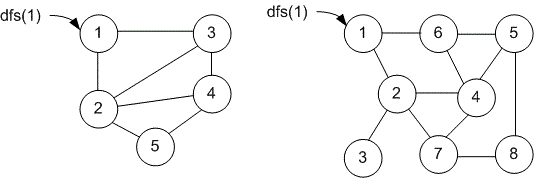Розбір
Let's build an adjacency matrix from the list of edges. Start a depth-first search from the specified vertex . Each time we enter a new vertex, we print its number.
Exercise
Solve the problem for the next graphs:

Algorithm realization — adjacency matrix
Declare an adjacency matrix and an array .
#define MAX 101 int g[MAX][MAX], used[MAX];
The dfs function performs a depth-first search from vertex .
void dfs(int v)
{Print the vertex .
printf("%d ", v);Mark the vertex as visited.
used[v] = 1;
Iterate over the vertices , that can be reached from . Moving from to is possible if:
There is an edge , that is, ;
The vertex is not visited
If both conditions are true, we continue the depth-first search from vertex .
for (int i = 1; i <= n; i++)
if ((g[v][i] == 1) && (used[i] == 0)) dfs(i);
}The main part of the program. Read the number of vertices and edges in the graph.
scanf("%d %d", &n, &m);}Initialize the arrays with zeroes.
memset(g, 0, sizeof(g)); memset(used, 0, sizeof(used));
Read the list of edges. Construct the adjacency matrix.
for (i = 0; i < m; i++)
{
scanf("%d %d", &a, &b);
g[a][b] = g[b][a] = 1;
}Read vertex and start a depth-first search from it.
scanf("%d", &v);
dfs(v);
printf("\n");Algorithm realization — adjacency list
Declare an adjacency list and an array .
vector<vector<int> > g; vector<int> used;
The dfs function performs a depth-first search from vertex .
void dfs(int v)
{Mark the vertex as visited.
used[v] = 1;
Print the vertex .
printf("%d ", v);The array contains a list of vertices adjacent to . Iterate over the vertices that can be reached from .
for (int to : g[v])
Consider the edge . We can move to vertex from if the vertex is not visited .
if (used[to] == 0) dfs(to); }
The main part of the program. Read the number of vertices and edges in the graph.
scanf("%d %d", &n, &m);Set the size of arrays and .
g.resize(n + 1); used.resize(n + 1);
Read the list of edges. Construct the adjacency list.
for (int i = 0; i < m; i++)
{
scanf("%d %d", &a, &b);
g[a].push_back(b);
g[b].push_back(a);
}Read vertex and start a depth-first search from it.
scanf("%d", &v);
dfs(v);
printf("\n");Java realization — adjacency matrix
import java.util.*;
public class Main
{
static int g[][], used[];
static int n, m;
static void dfs(int v)
{
System.out.printf(v + " ");
used[v] = 1;
for(int i = 1; i <= n; i++)
if (g[v][i] == 1 && used[i] == 0) dfs(i);
}
public static void main(String[] args)
{
Scanner con = new Scanner(System.in);
n = con.nextInt();
m = con.nextInt();
g = new int[n+1][n+1];
used = new int[n+1];
for (int i = 0; i < m; i++)
{
int a = con.nextInt();
int b = con.nextInt();
g[a][b] = g[b][a] = 1;
}
int v = con.nextInt();
dfs(v);
System.out.println();
}
}Java realization — array of ArrayList
import java.util.*;
public class Main
{
static ArrayList<Integer>[] g;
static int used[];
static int n, m;
static void dfs(int v)
{
System.out.print(v + " ");
used[v] = 1;
for(int to : g[v])
if (used[to] == 0) dfs(to);
}
public static void main(String[] args)
{
Scanner con = new Scanner(System.in);
n = con.nextInt();
m = con.nextInt();
g = new ArrayList[n+1]; // unchecked
used = new int[n+1];
for (int i = 1; i <= n; i++)
g[i] = new ArrayList<Integer>();
for (int i = 0; i < m; i++)
{
int a = con.nextInt();
int b = con.nextInt();
g[a].add(b);
g[b].add(a);
}
int v = con.nextInt();
dfs(v);
System.out.println();
con.close();
}
} Java realization — ArrayList of ArrayList
import java.util.*;
public class Main
{
static ArrayList<ArrayList<Integer>> g;
static int used[];
static int n, m;
static void dfs(int v)
{
System.out.printf(v + " ");
used[v] = 1;
for(int i = 0; i < g.get(v).size(); i++)
{
int to = g.get(v).get(i);
if (used[to] == 0) dfs(to);
}
}
public static void main(String[] args)
{
Scanner con = new Scanner(System.in);
n = con.nextInt();
m = con.nextInt();
g = new ArrayList<ArrayList<Integer>>();
used = new int[n+1];
for (int i = 0; i <= n; i++)
g.add(new ArrayList<Integer>());
for (int i = 0; i < m; i++)
{
int a = con.nextInt();
int b = con.nextInt();
g.get(a).add(b);
g.get(b).add(a);
}
int v = con.nextInt();
dfs(v);
System.out.println();
con.close();
}
} Python realization
The dfs function performs a depth-first search from vertex .
def dfs(v):
Print the vertex .
print(v, end = ' ')
Mark the vertex as visited.
used[v] = True
The list contains the numbers of vertices adjacent to . Iterate over the vertices that can be reached from . It's possible to go to vertex from if vertex is not visited .
for to in g[v]:
if not used[to]: dfs(to)The main part of the program. Read the number of vertices and edges in the graph.
n, m = map(int, input().split())
Create the adjacency list and the list .
g = [[] for _ in range(n+1)] used = [False] * (n + 1)
Read the list of edges. Construct the adjacency list.
for _ in range(m): a, b = map(int, input().split()) g[a].append(b) g[b].append(a)
Read vertex and start a depth-first search from it.
v = int(input()) dfs(v)